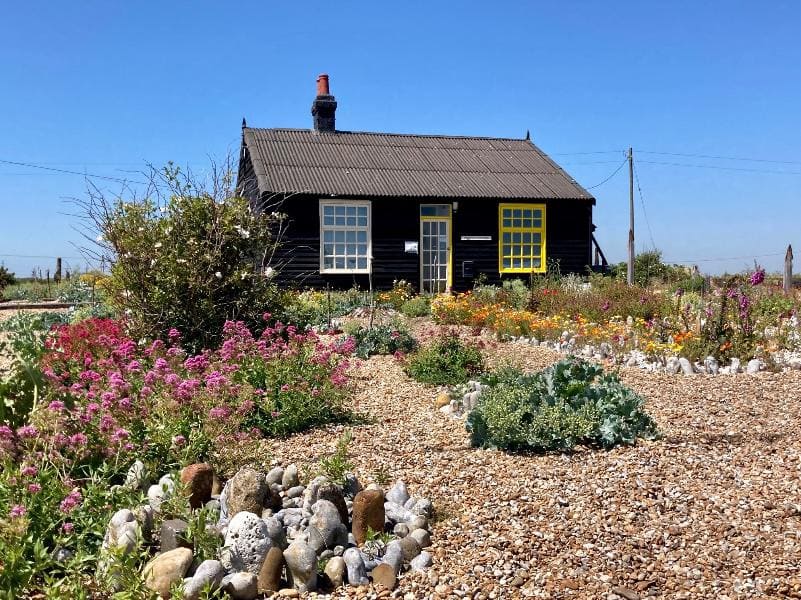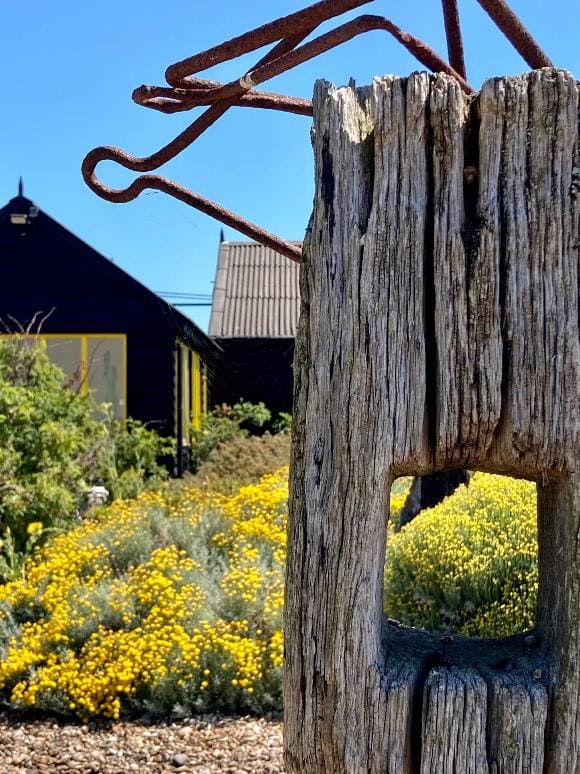Dungeness an Essential Pilgrimage for the Creative Mind
Naomi Elfred Ross Citizen Wang Studio
Article By Naomi Elfred-Ross @ citizenwangstudio.com
Dungeness, an Essential Pilgrimage for the Creative Mind
By Naomi Elfred-Ross
I recently visited Dungeness, which is on the Kent coast. I arrived, travelling through the salt marshes, by miniature steam train, courtesy of the Romney, Hythe and Dymchurch railway, which immediately created a sense of otherworldliness and definite charm. Then, on arriving, it felt like stepping into another country, or even another plane. To some; a fairy tale, and yet to others; possibly a surreal, post-apocalyptic nightmare. Every visitor has their own unique take.

Clambering up the brow of the shingle headland, revealing the stark, shimmering form of the Nuclear Power Station, with nothing but a big, blue sky, as a backdrop; I am put in mind of the planet Tatooine from Star Wars. Some have described the wild and desolate landscape of Dungeness as desert, but this wouldn’t be accurate as it rains too much! However, it is not typically recognisable as British. One thing seems to be clear, it is a place that you will either love or hate. For example, I think it takes a creative mind to find the dominating presence of a nuclear power station as beautiful, and yet it is evident that an artist’s community is flourishing there. On my visit, I had the opportunity to explore some of the local artists’ studios, in their timber hut, beach homes, which were open to the public. The surrounding landscape had clearly served as a constant source in inspiration and I could see why.


You may well be familiar with artist and Gay rights activist, Derek Jarman, who spent the latter years of his life, with his partner, in a blackened beach shack, with sunny yellow window frames; Prospect Cottage. Having moved from the hustle and bustle of London’s Soho, life would have been quite different for Jarman. However, at this stage in his life, he had been suffering with AIDS and was, in fact, one of the first (well known) people to have spoken out publicly about it. This was an extremely brave thing to do, at a time when there was so much controversy and prejudice regarding the disease and the homosexual community had been cruelly ostracised by society. However, Jarman was known for his openness and honesty in all matters and on this occasion, his candidness did much to educate a deeply unjust society, which had been fed lies by politicians and the tabloid press.
A medium Jarman often used to express his thoughts and opinions is film. Jarman is, perhaps, best known for his film making. Although he had said of himself, that he had no expertise in this area and worked in a vary unorthodox way; identifying more as a painter. I think this was part of the appeal though and is why they have since assumed a sort of cult like status. One of Jarman’s films, ‘Blue’ was filmed while he lived at Prospect Cottage and was dying from AIDS related illness. Having partially lost his sight, his vision was often interrupted by a blue light and so ‘Blue’ the film, is a static shot of the colour blue, with a voiceover and musical soundtrack. The voiceover consisted of diaristic and poetic text, where Jarman talks about his illness and impending death. Watching the film, I feel deeply moved that amidst so much suffering, he was still able to create something so important, powerful and beautiful.
The colour blue feels so appropriate to me, after my recent visit, as I feel I have the same colour tattooed onto my mind, as though a light has come on, which seems to have sparked a new direction in my creative pursuits and a new motivation. I often feel uncertain of my identity as an artist, and yet I have come away with a strengthened sense of my creative identity. I feel, having visited, that some much-needed space has opened in my generally chaotic mind, allowing new possibilities. Dungeness is, indeed, very open and some might say barren. It is true that not much grows there, except the most determined and hardy plants, such as viper’s-bugloss and sea kale and those so determinedly and careful teded by the Dungeness community. Otherwise, what can be found on the expansive shingle beach are various items that have washed ashore, there is a wealth of interesting maritime artefacts amongst these and sun bleached driftwood, to excite the imagination. These were all put to good use in Jarman’s well known and frequently visited garden, in which he lovingly tended a variety of hostile environment hardy plants. These were juxtaposed with playful sculptural forms, comprising of what treasure he had picked up on the shore.
These sculptures are positioned in such a way that give the garden and surrounding landscape a new sense of context and way of seeing and I had a field day experimenting with different compositions, on my cameraphone. I was intending to make use of these images, when I returned to London, so I could keep the Dungeness experience alive in my mind, until I returned and I definitely will. I have even suggested to my husband that we move there, but he thinks, perhaps sensibly, that the winter would be rather intense, as there is no shelter from the elements. He’s probably right, but life feels too short to be caught up too much with being sensible.



It seems interesting and perhaps not accidental that Jarman had been drawn to such a terrain of apparent hostility, when his experience of broader society had been along similar lines and yet here, he had the opportunity to find a unique place, in which he could belong and become part of his surroundings. Nothing living at Dungeness is there without resilience, as Jarman write’s in Modern Nature:
“I always thought of foxglove as a flower of the woods-deep in the shade, beloved of the bumble bees and little people. But the foxgloves of the Ness are quite a different breed. Strident purple in the yellow bloom, they stand exposed to the wind and blistering sunshine, as rigid as guardsmen on parade.”
At ‘the Ness’ there is no interest in looking to another with any petty intention such as to impose any judgement. All that lives is equal in its plight to survive, a place for misfits and outsiders. Perhaps, feeling as I often do, marginalised because of my mental health, this is something I can relate to and part of Dungeness’ allure.
For the artist; this surreal, open space seems to offer up a blank canvas, in which the creative mind can roam. There seems to be a freedom that I now know I was seriously lacking, cooped up in my London suburb home. In fact, since returning I realise just how unhealthy city living has become for me. I feel utterly intolerant of the noise, lack of space and general feeling of sensory overload. Now, all I need is to recall the immense sense of freedom I felt, as I stood atop of the old lighthouse, or at the edge of the expansive shoreline to know that it is possible to feel differently and that really keeps me going.


Dungeness and Prospect cottage has become a pilgrimage spot for the LGBTQIA community, artists, nature lovers and garden enthusiasts alike. It seems so apt that an artist who opened his doors and his heart to his friends and the wider community, can be remembered as his home and garden is opened up to the public and artists, thanks to funding raised by Art Fund. This ensures that his spirit, his love of nature, creativity and people should be able to live on for generations to come. Perhaps one day, in the future, I might be lucky enough to have an artist’s residency there, it feels unlikely, but in my emboldened sense of identity as an artist, I am going to permit myself to dream.

(Screen print by Naomi Elfred-Ross. July 2022)